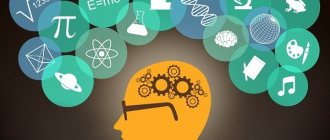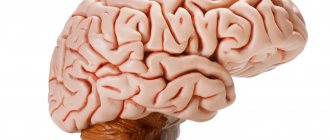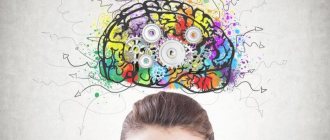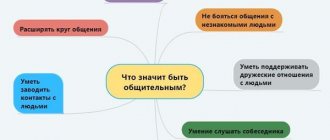Many people, back in school, dreamed of not spending hours memorizing poems, but memorizing them immediately after the first reading. In fact, people with such phenomenal memory exist, and it is called eidetic, photographic or visual. For those around them, they are real talents, they are admired, they want to be like them. But psychologists and especially psychotherapists do not all share such enthusiasm, because they consider this ability to be a serious deviation.
So what exactly is eidetic memory - a sign of genius that should be proud of, or a pathology that needs to be treated?
Types of memory
Information entering the brain is grouped under the influence of the characteristics of mental activity, measures of image awareness, the type of functioning goals, and duration.
Based on the organs of perception of objects, according to the characteristics of inferential activity, memory is divided into types:
- Imagery (created through sensations) differs according to the senses:
- visual;
- auditory;
- taste;
- olfactory;
- tactile.
- The motor form manifests itself in the form of preservation and reproduction of operations associated with movements (swimming skills, skating, cycling, football).
- The emotional aspect is revealed in feelings; it refers to the most reliable process of fixing objects. This is the preservation of experienced emotions (fear, shame, joy, anger).
- Semantic (semantic) group, where memorization is based on thinking processes and words. Such memory can be of a mechanical type (developed in the process of repeated repetition of information without comprehension) and logical type (based on the development of logical connections).
Based on the ratio of degrees of awareness, the following types of memory are divided:
- the implicit form is the preservation of images expressed unconsciously;
- the explicit subtype is based on the deliberate application of acquired information.
In connection with the goals of activity, the following types of memory are divided:
- unconscious thinking that appears in the mind regardless of the tasks assigned;
- conscious memorization, enabled by moderate retention of objects, associated with specific tasks.
Based on the duration of retention of pictures in memory, the following types are determined:
- instantaneous (sensory) mode, which retains information received from the senses without processing it;
- short-term form, characterized by short-term perception and reproduction of images in the first seconds after awareness;
- operational view, functioning only at the moment of performing specific tasks, then the information is erased after some time;
- long-term form refers to long-term storage of information, characterized by repeated use.
According to the purposes of the study, memory is divided into types:
- genetic (inherited);
- biological;
- episodic (saving individual fragments of images);
- reconstructive (correction of broken chains);
- reproductive (constant repetition of the reproduction of a stored object);
- associative (creating links between saved and existing objects);
- autobiographical (remembering events from personal life).
Ways and methods of memory development
To begin with, it is worth noting that we often train our memory and attention using various everyday situations in everyday life. We remember what we want to buy in a store, try to remember the birthdays of relatives, friends and acquaintances, retell the contents of a recently read book or textbook - all this and much more is good memory training
We remember what we want to buy in a store, try to remember the birthdays of relatives, friends and acquaintances, retell the contents of a recently read book or textbook - all this and much more is good memory training.
However, the use of special exercises gives us the opportunity to concentrate on the specific goal of developing a certain ability of our memory.
When talking about memory training, it is important to understand that it is almost impossible to directly train a specific ability to memorize material.
Memory always develops in close connection with our attention, perception, thinking, sense organs and other phenomena of human nature
Therefore, most of the exercises below produce a complex effect on our thinking, as well as on our memory as an important component of thinking.
For convenience, the exercises are divided into 2 groups: visual and auditory, and together they form an important part of our memory improvement training.
Study of the phenomenon
In 1907, the phenomenon of eidetic memory was discovered by the Slovenian scientist Viktor Urbancici.
The theory of this type of ability was studied throughout 1920-1940:
- Scientist Erich Jaensch made a great contribution to the development of science; his research was carried out at the University of Marburg (Germany).
- Soviet scientists made a great contribution to the development of the field: Lev Vygotsky, Pavel Blonsky, Sergei Rubinstein, Boris Teplov, Anatoly Shemyakin, Polina Ephrussi.
- The first mentions of the phenomenon were published in the books of Pavel Blonsky “Pedology” and Sergei Kravkov “Essays on Psychology” (1925 edition).
Scientists and researchers usually did not pay attention to the theoretical study of the phenomenon: most of the time was devoted to practical application. The works of scientists outline a large amount of information regarding the listing of the main problems of working with gifted children, a description of the results of experiments, the content of research protocols, and evaluation of the work done.
The 63rd volume of the Great Soviet Encyclopedia was published in 1963, and included Alexander Luria’s article “Eidetism.” The author describes in it the rarity of the phenomenon in its pure form and its spread in childhood, its extinction in adulthood, and the reasons why this happens.
Eidetic research was completely abandoned after the Great Patriotic War. In 1936, a direction in pedagogy came into force, which set as its goal to combine various approaches to science and methods of child education.
Causes of poor memory
Simple folk methods for improving memory Phenibut for improving memory How to develop photographic memory
Poorly developed visual memory is not necessarily the key to all troubles
This is not fundamentally important. But still, most information passes through the eyes
And in order to fully embrace the entirety of the world around us, we need to have a developed visual analyzer. Well-developed visual memory is the key to adequate learning and good memorization. The level of development of this type of memory affects the speed of learning and its quality.
The absence or insufficient attention to the baby, the lack of educational games and activities will certainly affect further learning and activity. But there are also acquired reasons for the deterioration and decrease in the quality of the “work” of the visual analyzer
Before this, my memory was good, no one complained, but over time I became absent-minded, you remember poorly and pay little attention to details. What are the reasons?
- Traumatic brain injuries, previous neuroinfections and cerebrovascular accidents - these pathological conditions will necessarily entail the destruction of a large number of nerve synapses and the nerve cells themselves. Trauma can damage precisely the department that is responsible for visual analysis.
- Age-related changes - every person develops encephalopathy to one degree or another. This occurs due to the gradual emptying of blood vessels, the formation of small blood clots in the lumen and disruption of the nutrition of glial cells and the neurons themselves. Brain cells gradually die off, and the number of actively working cells decreases sharply. The remaining nerve cells cannot cope with the previous flow of information and direct all their forces to more important matters - vital functions. And visual memory remains in the background for those cells that are not involved in important processes to ensure the normal functioning of the body.
- Intoxication and bad habits - any manifestation of euphoria without medicinal intervention of the appropriate group of drugs entails the death of a huge number of nerve fibers. Tissue is replaced and the brain is adjusted to provide more important functions. Therefore, visual memory suffers.
- Lack of nutrients in food - nerve cells need more than just oxygen. But also the nutritional elements that come with food. For example, insufficient consumption of fatty acids and vitamins, glycine lead to deterioration of brain function.
- Emotional and mental overload - nerve cells are on the verge of exhaustion, so we decided to take care of ourselves. They turned on lite mode, in which they protect themselves and do not work at full capacity. In this case, a good rest will return everything to its place.
If visual memory is poorly developed in children, this can lead to problems with memorization, learning ability, and, against this background, behavioral disorders in general.
Sometimes poorly developed visual memory can cause poor adaptation in the environment and society. A sharp deterioration in memory in an adult leads to absent-mindedness, decreased memory, difficulty in temporary adaptation, and psychological problems.
How does eidetism work in a child and an adult?
Photographic memory is an age-related feature in preschool children. It is usually lost during the transition to adolescence. Scientists have determined that eidetic images arose at the beginning of the emergence of human culture, but simultaneously with the development of civilization, the phenomenon disappeared, and abstract thinking took its place.
The phenomenon is most common in children and adolescents and is rare in adults. Scientists believe that the process of loss of eidetism is associated with a person growing up and learning the skills of obtaining information in other ways.
Professor Haber in 1969, in a series of numerous experiments on children , derived the rules with the help of which eidetics control images and their memorization:
- They don't look at the object for long.
- The image is erased by intense blinking of the eyes or by averting them.
- Information is stored in the form of visual or verbal images. Moreover, people with the phenomenon do not have two abilities at the same time.
For the process of memorizing and retaining images, such people need an emotional background, an understanding of objects or phenomena and, as motivation, interest in what is happening. If all aspects are observed, memory may omit or correct some details of the picture seen.
The memorization process is based on creating a picture, which is gradually joined by other types of memory: auditory, tactile, olfactory. Such memory cannot be perceived as an objective phenomenon, since it is subject to personal interpretation by a person, followed by the same reproduction of details.
What you need to know about photographic memory
In order to approach training correctly and effectively, you need to understand this type of memory.
In fact, scientists do not designate this type of memory as photographic. At the beginning of the last century, research was carried out on eidetic memory. Eidos is translated from Greek as image, appearance.
Eidetic memory is the ability to instantly remember information, but this memory is different from ordinary memory. The eidetic continues to see this image.
If you ask him how many buttons were on his friend's shirt. She will answer: “I’ll count now. So... one, two, three, four, five. Five buttons, they are white."
Images can be visual (photographic memory). But also other modalities. A person can smell, taste, feel, hear sounds.
Thus, A.R. Luria, describing Shereshevsky’s amazing memory in the Little Book of Great Memory, mentions that words for him were images.
If he was asked to remember a sound, then this image was accompanied by color. Gustatory, tactile and visual sensations were always added to the images he remembered.
His memory had no limits, he remembered any long or short series of words. He could reproduce them in a year, in 15 years, without a single error and without warning about verification.
Therefore, the development of figurative memory, the power of images, is of paramount importance in photographic memory. And we will start with them.
By the way, this is achieved due to the ideal interaction of both hemispheres of the brain.
Why are children geniuses from birth? Because up to 3 they have this amazing synchronicity. And those adults who own it are considered geniuses.
To preserve it in your children, play these games with them and read our article (will open in a new tab).
What about adults? To establish such interaction among us adults, go through and download the exercise here (link will open in a new window). Plus, it powerfully relaxes eyes tired from being stuck on gadgets.
Main characteristics
Photographic memory, which can be developed if desired, is characterized by the continued visualization of images after they have disappeared. The picture that appears before your eyes is so real that it can be examined in detail.
The main properties of photographic memory are:
- remembering visual images;
- a lasting imprint of pictures in memory;
- the ability to return to memorized material at any time;
- joining the visual image of other senses (auditory, sensory, olfactory);
- subjective interpretation of paintings.
Visual-image memory training
We bring to your attention four recognized and most effective techniques for training your visual memory. You can choose the option that is most suitable for you or use the techniques one by one to get maximum effect.
Black room
The technique may resemble a scene from a film about secret agents, where during interrogation the hero sits in a dark room with one lamp, and in front of him there is only a table. This is an ideal space, devoid of distractions, allowing maximum concentration on the subject of memorization. For such an item, it is proposed to take a simple sheet of A4 paper with printed information.
The technique is as follows: you sit down at a table with only this sheet on it and turn off the light, then turn on the light for a certain time and concentrate on this sheet, turn off the light again and from memory recreate this sheet in the dark in your head, try to read what is on German For convenience, a table lamp can serve as a light source. This exercise is aimed at developing visual memory and concentration, which is approximately reminiscent of photographic memory.
Schulte table
This table is presented in the simulators , and although it is positioned as an exercise in attentiveness, in its original version without complications, it allows you to see the entire field of the table and remember the location of the numbers on it. This training is effective for developing visual memory.
Artist's method
This technique is used by many artists who are interested in landscape painting, but it became famous thanks to I. Aivazovsky, who, in order to recreate realistic waves on the canvas, watched the sea for a long time, and then, closing his eyes, tried to recreate this picture in memory.
Using his method, you can observe any picture of what is happening, the main thing is to notice many details, and then, closing your eyes, train to recreate the same thing in memory.
Items on the table
For the exercise you will need two identical sets of objects of any nature and size that fit on the table. One of them needs to be thrown chaotically or laid out on the table, while the others will be needed to repeat the location of the first in another place.
First, you observe the position of the objects and the smallest details of their placement, after which you go to another room and try to repeat the same picture with a different set of objects. At first, you can repeatedly give yourself observation time and adjust the location of the second group.
As you can see, in fact, it is impossible to train phenomenal types of memory caused by the peculiarities of brain functions, however, by engaging in memory training and self-development, you can achieve the desired result, although it will be called by other terms, the main thing is that the benefits of these skills will qualitatively change your life.
Degrees
The classification of the degrees of severity of the phenomenon was compiled jointly by the scientist E. Jaensch and his collaborators.
The division into groups occurs in 6 degrees, starting from the 0th to the 5th measure:
- During the stage, an afterimage (a continuation of what was seen) appears in memory after the disappearance of the object. The degree is characterized by short duration.
- Next, the object is visualized (giving the image clearer boundaries). Strong sensations of visual perception are added to the afterimage picture.
- Continued fixation of the image not only with the help of vision, but also with the influence of sound signals. Deviations in the size and shape of memorized objects are corrected.
- Memorizing visual images of non-complex objects. In this case, fixation is no longer required, complex objects are partially remembered.
- Bringing clarity and completeness to the visual image of complex objects.
- Complete visualization of complex images with all the small details.
According to the degree of severity of the phenomenon, a classification occurs of people who have the ability for logical representation, which are divided into 2 types:
- “T-type” represents people who have persistent and long-lasting imagery that does not require stimulation.
- “B-type” represents the type of people who have the ability to voluntarily awaken phenomena and consciously adjust images.
Associations
Associative thinking is another key to developing photographic memory. You need to create your own list of associative pictures, which psychologists call an “anchor list.” Words from this list should, according to psychologists, be associated with any arbitrary word, causing a strong association in your mind.
Thus, you can “add” two or three words to each word from your list. After two weeks of such exercises, you can memorize entire texts. It's the same with numbers. Any combination of numbers can be divided into numbers that will cause you a certain association with some event in your life or the lives of other people (even on the scale of an entire country).
What is the difference between visual and photographic memory, and which one needs to be developed?
Visual memory is the ability to remember visual images. If she is able to remember objects for a long time and accurately, then she moves into the region of the eidetic type.
Photographic memory, which can be developed over long periods of training, differs from visual memory by effortless memorization, that is, a lack of interest in retaining information.
In the case of a phenomenon, the process of storing information in the brain is as close as possible to photographing, that is, literally capturing the picture: as it is with all the details.
Visual memory captures an object without focusing on details, and possibly distorts them.
On a subconscious level, experts recommend developing photographic memory by expanding the capabilities of visual touch. There are developed training methods and exercises that you can perform at home in your free time.
Paired images
This game is considered a children's game, so you can find it in the section of children's online games. Most often it is called “Paired Pictures”. Initially, such games were considered board games. The essence of the game is to collect pairs of identical pictures as quickly as possible.
To do this, players open any two cards, which are laid out face down in four or eight rows. You need to turn over any two pictures: if they match, they are removed to the side. If not, you need to remember where each picture remains, so that later, when a pair opens, you can quickly remember where the original option was and open both identical pictures.
In the electronic version you can play very quickly, then playing alone really turns into training. Try to memorize 64 pictures at once, even in pairs!
How to prepare your brain?
The brain, like any other part of the human body, needs a balanced diet, sufficient rest, and moderate physical activity. By normalizing your lifestyle and maintaining it at the same level, you can significantly increase your mental abilities and improve your memory.
Dream
Healthy sleep helps brain activity reboot. In this way, the body “sorts out” all the information it receives during the day, and gets rid of unnecessary information.
During sleep, nerve fibers sort through memories, analyze what is important and what is not. Next, the brain stores the information received in certain areas of memory. This process is called consolidation.
Scientists recommend monitoring the quantity and quality of sleep. The normal duration of rest hours should be 7-8 hours.
Nutrition
The functioning of the nervous system is greatly influenced by proper nutrition. It is normal when the diet includes a sufficient amount of vitamins, fiber, proteins and healthy fatty acids.
It should be borne in mind that flavor enhancers and preservatives reduce mental performance, as well as red meat and alcohol, so it is recommended to include more natural foods in the menu. The Mediterranean diet is especially beneficial in summer.
The diet must include:
- fresh fruits;
- dairy products;
- whole grain dishes;
- pasta;
- leguminous plants;
- nuts, seeds;
- vegetable oil;
- fish;
- bird.
Physical exercise
The physiological side of the issue implies not only the presence of proper nutrition and a rational regime of wakefulness and sleep, but also moderate physical activity in the form of:
- morning exercises;
- walking in the fresh air;
- running;
- dancing.
Research has shown that regular physical activity improves cognitive function. During exercise, a substance is produced in the brain that promotes the restoration of neurons and the reconstruction of connections between them.
Experiments with texts
Try the following exercises. The text is printed on one sheet in a regular format with medium-sized letters (14 point). On another sheet of paper with the same text, your assistant should type some extra word. After reading the first sheet, you need to immediately turn your gaze to the second and quickly find the extra word.
Then there may be more and more such words, and the time to search for them becomes less and less. By the way, such work can, oddly enough, be helped by a game from the “Find the Cat” or “Find the Dog” series on the Internet. By playing it, you develop your ability to quickly find the “extra” in the picture. Agree, a cat looks out of place among school supplies. Your eye will learn to “catch” on such little things, and your training in finding extra words in the text will progress more successfully.
Development of photographic memory without complex training. Practical techniques
People who have good visual memory abilities can train to improve their eidetic memory. It is also necessary to practice for those people who do not have special abilities, but the techniques will help them develop brain activity.
You can exercise anywhere: on the way to work or school, while walking, in line at a store, at a public transport stop.
Practical techniques are based on the following methodology:
- You must watch for 30 seconds. to an object (phenomenon, person).
- Then, averting your eyes, try to reproduce all the details of what you saw in your memory.
Advertising and information for visitors can be considered as materials for memorization. The skill needs to be periodically checked to see how much all the gaps in the image are filled. You should not expect results to appear quickly, but with persistence you can still improve eidetism without special exercises.
Famous people who had a photographic memory:
- Ronald Reagan, American President, he could memorize an entire page of text in a few seconds just by looking at it.
- Shereshevsky Solomon, writer, artist, journalist, had a good photographic memory.
- A librarian in Italy who lived in the 17th century read over 40,000 books and knew them by heart.
Photographic memory can be developed like any other memory. You choose an object that you want to capture, photograph it and then reproduce it in your memory. Photographic memory, like a camera, pointing the camera, clicking and that’s it.
You can train your photographic memory everywhere at home, at work, on the street, in a store, in the theater, and so on.
For example, you are walking down the street and a person comes towards you, take a photograph of this person and stop looking at him, create his image in front of your eyes, describe this person in your mind. What is he like? What are you wearing? What are the facial features? What does he have in his hands? And so on.
You may not be able to take a high-quality photograph and describe the image of a person; this requires constant training. Over time, you will notice the improvements yourself.
Training should take place in a good positive mood; a positive attitude always helps to achieve the desired result.
Trainings for mastering eidetism
Photographic memory (practical techniques will help develop the memorization process) can be trained at home. There are many techniques that develop eidetism in a short period of time.
These include:
- Schulte tables;
- special games;
- neurobics;
- Aivazovsky's method.
To make the training process more productive, you need to look for associations in the images you see.
Simple exercises to develop photographic memory
There are a number of simple exercises that can improve your thinking and memory:
- You need to find 2-3 mathematical, chemical or physical formulas. You need to look at each formula for 15-20 seconds. and imagine how it is registered in memory. Then you should close your eyes and check what you remember. Training should begin with easy formulas and systematically complicate them.
- You need to look at part of the text without reading, instead try to photograph it (take it in with your gaze). Next, you should close the book and write down the material that you remember. The training is performed as many times as needed to reproduce the entire text.
- You need to remember the largest number of numbers that are written in a column or line. The number of numbers should gradually increase.
Exercises with Schulte tables
Special tables with a random arrangement of numbers, having sizes from 3x3 and larger, consisting of numbers or letters, can help develop photographic memory.
Using the method developed by the German scientist Schult, it will be possible to improve peripheral vision and, as a result, memory. Tables can be downloaded for free from the Internet, printed or found in special applications (programs that work online).
The essence of the method is to fulfill the following conditions:
- You need to look strictly at the center of the table and use your peripheral vision to find numbers or letters in ascending order. In this case, you need to take into account the speed of finding symbols.
- During training, you cannot say anything to yourself (pronounce).
- To achieve good results, you should practice daily, but no more than several times.
- If it becomes clear that with each subsequent exercise the speed of passing the test drops, then the process must be stopped and rested for 15-20 minutes. During rest, you should not read, watch TV or carry out any mental work.
To start training, small tables measuring 3x3, 4x3 are suitable. Gradually the size of objects should increase.
Games
Japanese professor Makato Shichida is known for developing many games for children and adults to develop photographic memory.
The games offered by the professor are summarized in the table:
Photographic memory. How to develop through games
| Name | Props | Description |
| What has disappeared and what has appeared? | Cards with different images | You need to lay out 3 cards and examine them for 10-20 seconds. and close your eyes. Then increase the row or remove one card. As a result, you need to track what has disappeared or appeared. The game starts with 3 cards and gradually increases to 10-20. You can make the exercise more difficult by adding or removing 2-3 additional cards. |
| Place the blocks correctly. | Block constructor of different shapes and colors | It is necessary to fold a two-level structure with 3 cubes in each row. Next, the structure needs to be disassembled and folded correctly. You don’t have to assemble the initial design, but draw it on paper and then do it from memory. The game becomes more complicated through the introduction of blocks of different shapes and colors into the construction, increasing the number of levels and elements in the rows. |
| Find matching pairs. | Playing cards or with images that are duplicated | You should take 3 cards from the deck, examine them and place them face down. Then you need to select 3 identical cards from the deck and arrange them into corresponding inverted images. The pairs must match. Gradually the number of cards can be increased to 10-20. |
Neurobics
A set of exercises that help develop mental activity is called neurobics.
The method was developed by the American scientist Lawrence Kats; it involves the involvement of all 5 human senses, and each of them must learn to work in a new context. During exercise, neurotropin is produced, a substance that promotes the formation of new connections in brain cells.
The complex includes the following exercises:
- Exploring new smells (should be inhaled immediately after waking up). The method is explained by the fact that the sense of smell serves as the only conductor that is connected to the emotional centers of the brain.
- Reading magazines is not of interest. It is necessary to diversify the information received.
- Leg exercises. Scientists have proven that the soles of the feet contain a large number of nerve endings that interact with the brain. In order to implement the training, you need to learn how to perform some actions with your feet (picking up a pillow that has fallen from the sofa).
- Reading aloud.
- Expressing your thoughts using new words, that is, forming the same ideas in different words.
- Changing the usual pace of life and actions (people who are used to working quickly need to slow themselves down and vice versa).
- Training with the other hand (if the working hand is right, then you should switch to performing tasks with the left).
- Finding connections between unrelated objects (find something in common between an apple and a pear).
Aivazovsky method
A set of exercises that develop photographic memory is based on the peculiarities of perception of the great Russian artist, who could imagine a wave at a certain time and capture it on canvas, preserving the sensation of movement.
Exercises according to I.K. Aivazovsky consist of the following algorithm:
- It is necessary to select an object that is examined for 3-4 minutes.
- Next, you need to close your eyes and mentally reproduce the image in your mind.
- The resulting picture should be compared with the original.
- The exercise must be repeated every day 1-3 times until it is possible to create an image in memory that matches even in detail the selected object.
Exercises for developing photographic memory in combination with games and special training available online can help develop your abilities and open up new horizons professionally or creatively.
You can train daily with exercises
Exercise 1. Take a photo of the object
Take some object, for example, a figurine, look at it for ten seconds, take a photo of it, then close the figurine and tell it or draw it from memory.
Check your story with the original figurine and compare whether you photographed everything or not.
Exercise 2: Take a photo of the painting
Take a picture, if there is no picture, you can take a picture in a book, look at it for ten seconds, take a photograph of it, then close the picture and tell from memory what is depicted in this picture.
Check your story with the original picture and compare whether you photographed everything or not.
Exercise 3: Take a photo of the carpet
Look at the carpet, if there is no carpet, you can take a picture of the carpet, look at it for ten seconds, take a photo of it, then turn away from the carpet and tell from memory what is depicted on this carpet.
Check your story with the original carpet and compare whether you photographed everything or not, compare the correctness of the description of patterns and colors.
Exercise 4: Take a photo of the formula
Take any complex mathematical or chemical formula.
Take a photo of it, then close this formula and try to write it from memory. Open the formula and check whether you wrote it correctly or not.
Exercise 5: Take a photo of a paragraph in a book
Take any paragraph in a book from five to ten lines, look at it carefully for thirty seconds, take a photograph of it, then close the book and tell from memory what is written in this paragraph.
Check your story with the paragraph in the book and compare whether you have photographed everything or not. Repeat the exercise again.
Exercise 6. Take a photo of a series of numbers
Take any series of numbers, look at it carefully for thirty seconds, take a photo of it, then cover it and write it down from memory. First memorize the first line and write it down, then memorize the second line and write it down, and so on.
92374859
4758603647
95736247596745
9837564424237587977
34868708846241315756879
Check what you wrote and the written series of numbers and compare whether you photographed everything correctly or not. Repeat the exercise again to make sure there are no mistakes.
Exercise 7: Take a photo of the words
Take any words, look at them carefully for thirty seconds, take a photo of them, then cover the words and write from memory. First memorize the first two lines and write them, then memorize the second two lines and write it down, and so on.
Car, hare, raspberry, lungwort, pluto, ermine, bird cherry, turtle, sensor, universe, bear, ocean, formula, cinema, flora.
Dacha, garden, dinosaur, article, twenty-sided, mug, horns, money, picture, bed, rebus, engine, lark, carousel, dolphin.
Check what you have written and the words you have written and compare whether you have photographed everything correctly or not. Repeat the exercise again to make sure there are no mistakes.
Exercise 8. Take a photo of the matches
Take twenty matches and throw them on the table to make some kind of drawing, look carefully at the drawing from the matches that you get.
Take a photo of it, turn away from it and try to post it exactly the same as you took the photo.
Check these two pictures and see if they are different or not. If they are the same, then take thirty matches and do the same thing.
The best advice from doctors and coaches on how to develop memory
Human memory can be developed through exercise and systematic training. They improve memory abilities. This was confirmed by championship participants from around the world. Many of them claimed that they did not have phenomenal memory abilities until they began to train constantly.
To increase the effectiveness of exercises, you should give preference to those that are pleasant to perform. If any exercises cause discomfort or irritation while performing them, you should not practice them.
The development of logical thinking plays an important role in the process of memorization. Memory formation is based on systemic perception of information
Solving logical problems will help increase concentration, enhance attention and activate mental processes.
To develop memory and attention, it is necessary to take care of improving cerebral circulation. To do this, it is recommended to spend more time in the fresh air, perform breathing exercises and practices, go for a run, etc.
How to develop memory for an adult
In order to maintain a good memory for many years, you must fulfill 1 simple condition: constantly load your brain with new information. Without receiving fresh emotions and sensations, the brain stops working in the correct mode. By doing the same routine work every day, he gets used to it, and actions are performed automatically without concentration.
As soon as a person stops learning and absorbing a lot of new information, his brain begins to slowly age, regardless of biological age. To prevent this process, intellectual work is necessary: learning foreign languages, acquiring new skills, etc. In this way, not only professional memory will develop, but also emotional and mental memory. Curiosity will be the impetus for new knowledge.
Memory development in children
To develop memorization skills in children, the use of special methods and techniques is not required. You can begin to develop memory as early as 6 months. To do this, you need to play exciting games with your child.
When he reaches 10 months - 1.5 years, you can practice the following game: hide various toys with him that he needs to find. Then you need to move them to other places.
At 2 years old, it is recommended to complicate the game: place 3-4 objects in front of the child, and then remove 1 of them. The child must remember what the missing object was.
At the age of 3, it is recommended to actively learn songs, poems, tongue twisters, and dances. At this age, all types of memory can be developed.
How to quickly develop your memory
Neurobics is a brain exercise that helps activate all processes in it that contribute to memory development; the psychology of its formation depends on many factors.
Unusual actions are the best training for brain activity. To activate it, you need to perform the following simple exercises:
- brush your teeth or comb your hair with the other hand;
- use different scents of perfumes;
- regularly introduce new actions into your morning ritual (eat fruit, do exercises, etc.);
- use new culinary recipes more often;
- listen to unusual music and perform familiar actions to it;
- rearrange furniture;
- update your wardrobe.
Types of memory depending on what we remember
People encounter a wide variety of information, which reaches the brain in different ways. Experts identify forms of memorization based on what mental processes were involved.
Figurative memory
The memory department has the largest volume, which should store images obtained through the senses.
Vision provides visual information, incl. and in printed form. Human speech, sounds of nature, and music pass through the auditory canal. A person receives tactile sensations through touch, smells through smell, etc.
Pictures of what is happening around enter the human brain immediately after birth, which is facilitated by imaginative memory. Some people have a special type of memory, thanks to which they can reproduce in detail what they saw, heard or felt.
Motor or motor memory
This ability was characteristic of people at the dawn of evolution. A person often does not realize how important the motor type of memory is for him. Thanks to him, he can not only play sports, dance, but also perform simpler actions, such as making notes in a notebook, pouring water, etc.
Emotional memory
Often a person attaches little importance to the reproduction of feelings or emotions. However, without this process, people's lives would lose meaning. Emotional memory is always associated with associations, i.e., memory occurs with the complete or partial repetition of an event. Sometimes one detail is enough for emotions to arise. However, in memories they will be expressed less intensely than at the time they were received.
Information that has an emotional connotation is always remembered better.
Verbal-logical memory
The verbal-logical form is characteristic only of man. Even if an animal remembers some words, it is only as sound combinations that are associated with a visual, auditory or olfactory image. The process of comprehension is inherent in man.
The best way to remember is through the process of perceiving the text, not individual words. Logical memory is one of the youngest types of mental processes. It requires awareness, which can only be developed purposefully.
How to quickly develop your memory to remember better
1.
A method that can not only improve memory, but also develop imagination well! Surely, before going to the store, you often make a shopping list. After studying the list before going out, try to come up with a short fairy-tale story, the heroes of which will be all your potential purchases. This exercise can be interesting not only for adults, but also for children. When you come to the store, try to make purchases based on your “fairy tale”. Of course, before leaving the supermarket, check the list and check how well you remember your own work.
2.
Another interesting method that can be used using a regular grocery list as a basis. Remember to remember it by first dividing it into groups - five products from the vegetable department, three products from the dairy department, two products from the meat department. Make sure that by grouping your list you will remember it faster.
3.
This exercise can be done regularly before bed. Remember all the details of the past day, scroll through it in your head. remember what you did today, starting in the morning - what you ate, who you talked to, what you did, and so on. Now try to remember the past day from the current moment until you woke up - that is, in reverse order. This can be challenging, but is very effective for memory development.
4.
If you want to develop your memory, then remember that for this you need to get enough sleep in order to ensure full brain function. In the absence of normal sleep, the memory will not be able to work “at full capacity.” In addition, the human brain is tuned to a biological rhythm in which day gives way to night, so you should sleep in the dark, at least seven to eight hours!
5.
If you want to have an excellent memory, avoid drinking alcohol. It has long been known that drinking alcohol contributes to a significant weakening of memory. By the way, the more alcohol you drink, the weaker the fixation of your attention, and, accordingly, the memory itself. It is especially undesirable to drink alcohol if you have an important meeting, participation in a conference, and so on.
6.
Try to eliminate smoking from your life, if it occurs. According to scientists, tobacco has a negative effect on memory, which has been confirmed by numerous studies. If you set out to improve your memory, then this is a great reason to quit smoking.
— Mnemonics or “the art of memorization.” Example
______
However, there are special techniques that can significantly improve memory in a very short time and almost forever remember a large amount of information: unrelated data, numbers, texts, foreign words. This is possible thanks to the methods of mnemonics (the word “mneumonica” comes from the Greek language and means “the art of remembering”).
Almost all mnemonic methods are based on creating associations for memorized information with very vivid, grotesque images that are difficult to erase from memory.
4 steps to memorize using the associative method:
1) Encode information into vivid images.
2) Create grotesque associative connections between images. 3) Remember the sequence of connections through a grotesque plot or scene. 4) Mentally visualize a plot or scene to reinforce the sequence of connections.
This method is used to remember information such as unrelated data, long numbers, historical dates. Once you master this technique, you can memorize all this data in a matter of seconds and store it in your memory almost forever. Miracle? No, this is just another innate ability of our brain - the ability to create associative connections between memories.
The memory stores simple images that are used as reference points to reconstruct more complex images or scenes. In computer science terms, such images are the root directory for our memory.
The more simple and grotesque the images into which information is encoded, the better they will be retained in memory and will never be mixed with similar images. You can illustrate the application of this method in practice using a clear example. You need to remember which clients of your company and in what order you need to call during the day. Even if you remember the clients' names, it will still be difficult to remember in what order you should communicate with them. Exercises to improve memory and brain function can help you here.
Let's say you spend a lot of time learning a sequence of phone calls, but the next day you won't be able to accurately remember all the information, and a week later you'll even forget the sequence of four clients. If you show creativity and create vivid images that are associated with each of your clients, and then come up with an associative connection, you can easily remember everything a month or even a year later.
Suppose the clients in the telephone call list are in the following order: Maria (housewife), Peter (lawyer in a law firm), Lucia (flower seller), Andres (airplane pilot), Monica (secretary of a consulting holding company), Nicholas (engineer), Isabel (bus driver), Carmen (psychology professor).
Step one: encode information into images.
Maria (housewife): you can imagine a girl in a swimsuit with a huge MARK on her back (the initial letters of the word help you remember the name), flying on a broom along the shore (a broom is associated with housekeeping). It's rare to see a girl with a broom at sea, isn't it? This is a grotesque image that is perceived by our consciousness very easily. It cannot be confused with a real life image.
Now we need to build a grotesque image for the next client, Peter. You can imagine a man dressed in an ancient robe with a COCK in his hand (association based on the initial letters of the name). The clothes in which we present Peter immediately associate him with the profession of a lawyer. To help you remember the image even better, you can add more details (for example, an unusual hairstyle or facial expression).
Step two: create an associative connection between the created images.
For example, Peter wants to catch and protect Mary, since she is wanted by the Inquisition on suspicion of witchcraft. This is a grotesque connection that would hardly be possible in the real world, so our memory will not be able to confuse it with a real event.
Step three: remember the sequence of connections by constructing a plot.
Now you need to come up with a specific action that will connect the characters in a certain sequence. This must be an action, and not a static image, if we want to remember the entire chain of clients in a certain sequence for a long time. For example, we can imagine Peter running along the shoreline with a rooster in front of him to catch up with Mary, who is flying ahead on her broom.
Step four: mentally visualize the scene.
We present the invented plot as a movie on the screen. The resulting scene should be vibrant, with all the details we've created for the characters. This will allow you to remember the entire chain for a very long time, if not forever.
The method may seem complicated, but if every time you need to remember unrelated information with different parameters (as in the example described), instead of cramming, you use images and connections, you can develop your creativity so much that it will take several minutes to think through the plot. In addition to improving memory, it also develops creative abilities, which is highly valued today in any profession.
You may also be interested in the topic of visual memory development.
_______










